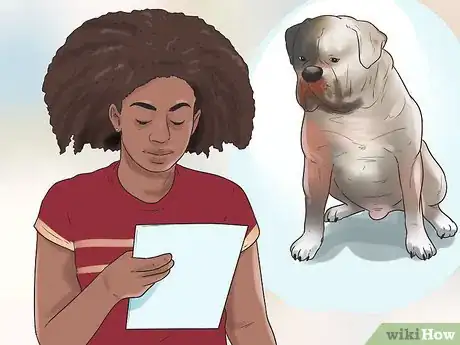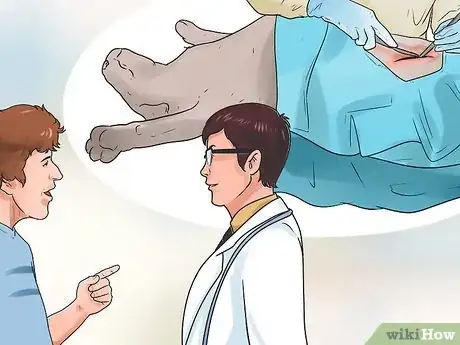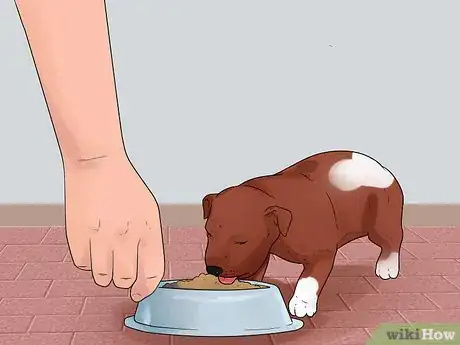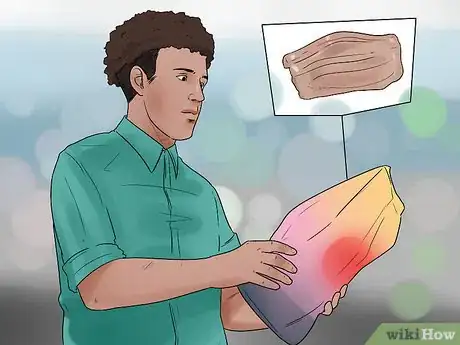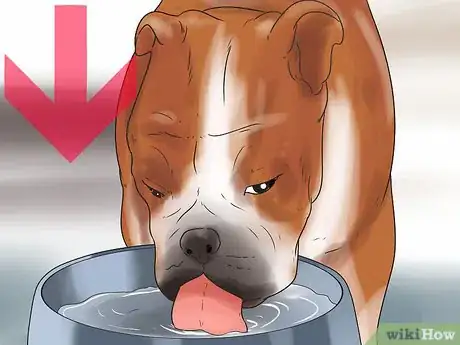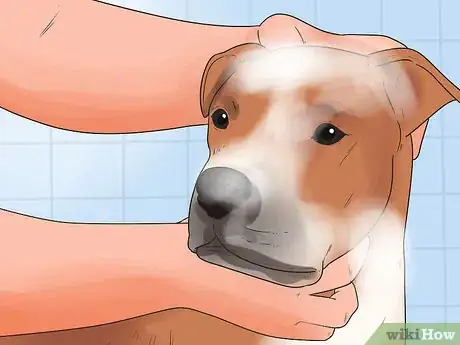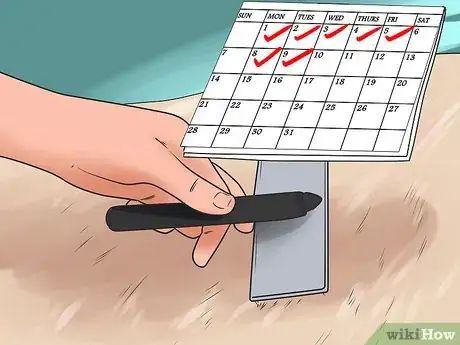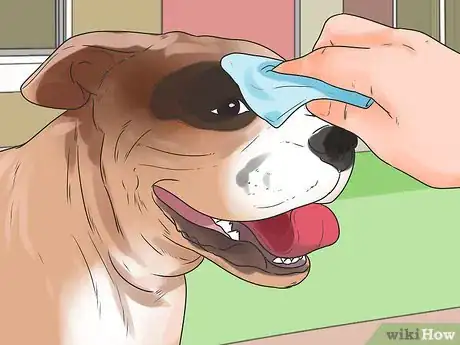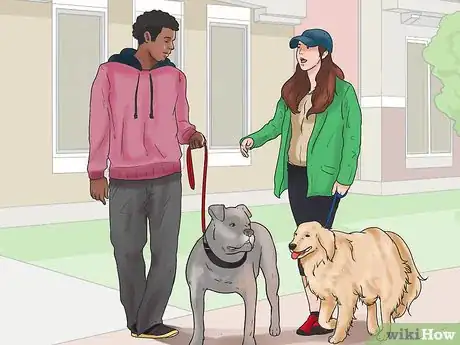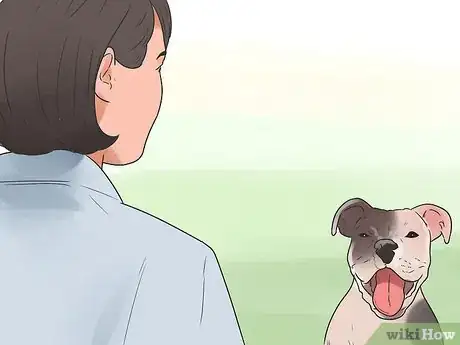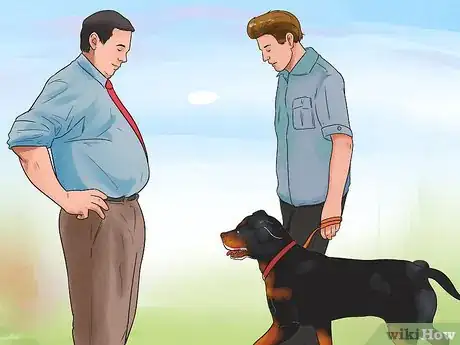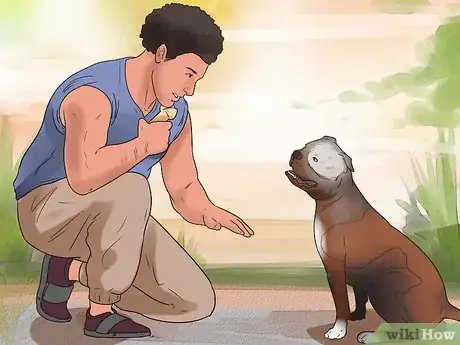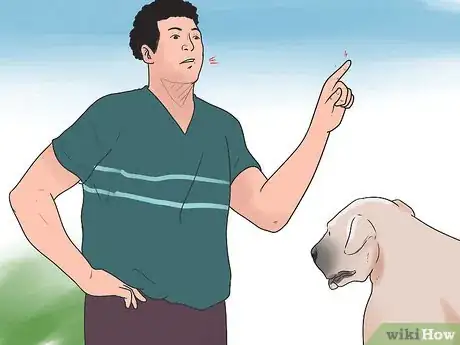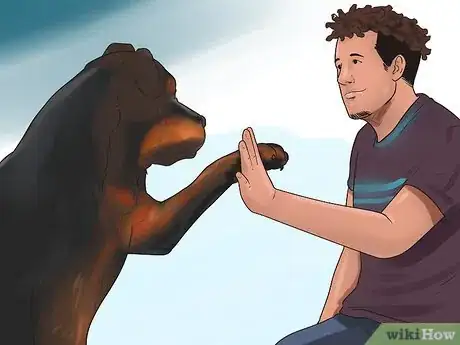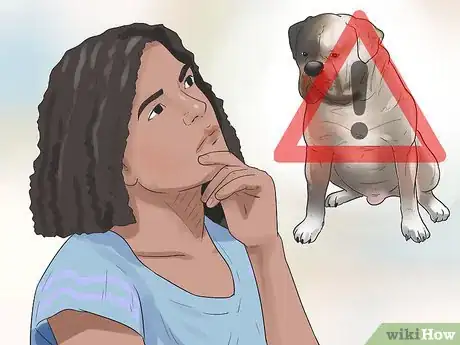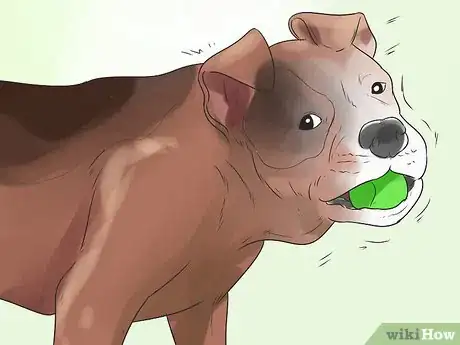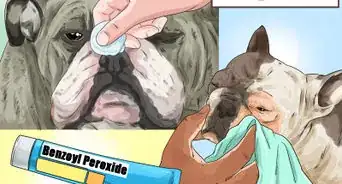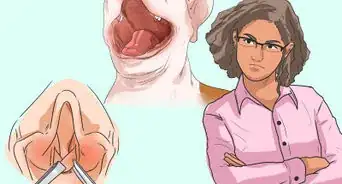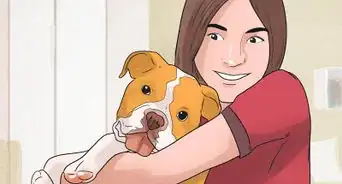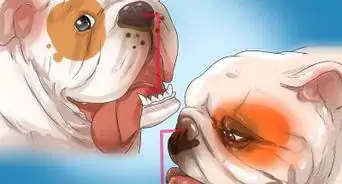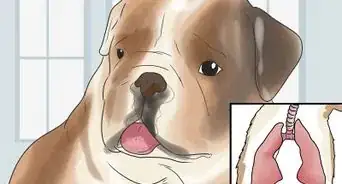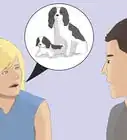This article was co-authored by Brian Bourquin, DVM. Brian Bourquin, better known as “Dr. B” to his clients, is a Veterinarian and the Owner of Boston Veterinary Clinic, a pet health care and veterinary clinic with three locations, South End/Bay Village, the Seaport, and Brookline, Massachusetts. Boston Veterinary Clinic specializes in primary veterinary care, including wellness and preventative care, sick and emergency care, soft-tissue surgery, dentistry. The clinic also provides specialty services in behavior, nutrition, and alternative pain management therapies using acupuncture, and therapeutic laser treatments. Boston Veterinary Clinic is an AAHA (American Animal Hospital Association) accredited hospital and Boston’s first Fear Free Certified Clinic. Brian has over 19 years of veterinary experience and earned his Doctor of Veterinary Medicine from Cornell University.
There are 8 references cited in this article, which can be found at the bottom of the page.
wikiHow marks an article as reader-approved once it receives enough positive feedback. In this case, 90% of readers who voted found the article helpful, earning it our reader-approved status.
This article has been viewed 301,248 times.
The American Bulldog is a loyal, protective, energetic, and confident breed. These dogs are known for their strong will and should belong to a person that is willing to work hard with them to establish a dominant role in the relationship. This breed is known as an excellent family dog and, through proper socialization with people, dogs, and cats, they will be extremely friendly to anyone they meet. If an American Bulldog respects you and wants to please you, you will have a very loyal dog standing next to you. No matter what your American Bulldog's personality is, this breed is very protective and will more than likely be an excellent security system for your home and family.[1]
Steps
Taking Care of Your American Bulldog's Health
-
1Make sure that your dog has had all of its necessary immunizations. Vaccinations play an important role in any dog’s health, including your American Bulldog's. The standard immunizations for dogs include Rabies, which is administered at 12 weeks of age or older and then every 1 to 3 years depending on your local laws and your vet’s recommendations. Distemper, Parvovirus, Hepatitis, and Parainfluenza are usually administered together.
- Puppies should receive a set of four injections every three weeks starting at six weeks of age and then annually, as adults, again based on your veterinarian's recommendations.
- Your veterinarian will also make recommendations for items such as monthly heartworm preventive, flea & tick preventive, and deworming protocols based on the season and specific region you live in. Routine physical exams, which can include fecal exams, a heartworm test, and routine blood work will help detect any health issues that need to be addressed in order to maintain your American Bulldog's long-term health.[2]
-
2Get your American Bulldog spayed or neutered. Spaying and neutering are procedures that prevent unwanted pregnancies and can help to eliminate many health and behavioral issues. Neutering can prevent testicular cancers, prostate problems, urinary marking, and some aggressive behaviors in males. Spayed females have a greatly reduced incidence of mammary tumors and no possibility of uterine infections or uterine cancer.
- Ideally an American Bulldog puppy should have this done at around six months of age. Discuss this procedure with your veterinarian during your regular puppy visits or at the first visit after adopting an adult dog.[3]
- Your bulldog's recovery time shouldn't be long, but it's important that you keep your dog relaxed and prevent it from licking its wound while it heals.[4]
Advertisement -
3Understand that American Bulldogs are prone to certain health conditions. Some of the more common ones include, but are not limited to, brachycephalic syndrome, laryngeal paralysis, hip dysplasia, deafness, hypothyroidism, entropion, and prolapse of the third eyelid. Most of these health concerns are treatable. Some may only require a simple medication while others may need to be corrected with a surgical procedure.[5]
- Consult with your veterinarian if you have any health concerns regarding your American Bulldog. If you see the signs of any of these conditions, for instance, if you suspect that your dog cannot hear you or your dog is in pain while walking (a sign of developing hip dysplasia), it is best to get your dog checked by its vet.
- One way to avoid many of these problems is to get an American Bulldog puppy that has been well-bred. Good, experienced breeders take the time to breed dogs so that there are less chance of these health conditions. Dogs that have been inbred, on the other hand, have a higher chance of inheriting hereditary health problems.
Feeding and Grooming Your American Bulldog
-
1Feed an American Bulldog puppy a high-quality puppy food made specifically for large breed puppies. This helps to ensure that it maintains healthy bones and joints while it is growing. The puppy should remain on this diet until it is around 18 months of age. It can then be considered an adult and gradually be switched to adult food.
- Feeding your puppy a large-breed dog food will ensure it gets all the nutrients it needs to grow strong and healthy.[6]
-
2Find a high-quality food that features meat as the first ingredient listed on the bag's label. This will give the American Bulldog the protein it needs and it will limit the number of carbohydrates it consumes. Crude protein should be no less than 30 percent and crude fat no less than 20 percent. The fiber content needs to be 4 percent or less.
- As a general rule of thumb, look for dog food that contains ingredients you can pronounce so you're not buying foods with a lot of unhealthy additives, colors, and dyes.[7]
-
3Reduce the risk of gastric dilatation-volvulus, also known as bloat, through diet. American Bulldogs are large breed dogs and thus are susceptible to GDV.[8] This is a life-threatening condition and requires immediate veterinary treatment. To help prevent this from occurring there are several things related to feeding that can be done. Feed two or three smaller, non-fatty meals a day, not in elevated bowls, and don’t mix dry food and water.
- Also, restrict your dog’s activity for at least an hour after feeding and discourage them from drinking large amounts of water at one time.
-
4Provide unlimited access to water. It is always important to allow your dog access to a fresh, clean water source. This breed will need to drink as desired. Keep a hand towel nearby for wiping up excessive drool or slobber that, unfortunately, is a common occurrence for this breed.
-
5Bathe your American Bulldog only when necessary. American Bulldogs tend to have short, smooth hair that rarely requires bathing. In general, their coat is easy to maintain. Just give your pup a bath if it rolls in something smelly or is physically dirty.
-
6Brush your American Bulldog on a regular basis. American Bulldogs do shed much more than you would think.[9] Invest in lint rollers for your furniture and clothes if shedding becomes an issue for you.
-
7Clean the folds around your American Bulldog's face regularly. Because American bulldogs have short muzzles, which gives their face a "smushed" appearance, some dogs tend to have excess skin folds between their eyes and nose. It is easy for dirt and moisture to get stuck in these facial folds and cause irritation and odor. Be sure to clean or wipe in between the skin folds regularly with a damp paper towel or washcloth and mild soap.
- Try to avoid getting any soap into your dog's eyes. If this happens, rinse its eyes thoroughly with clean water.
- Most veterinary offices carry wipes that are safe to use on the face and near the eyes, specifically for this purpose.
- After cleaning between the dog's facial folds, use a new, clean paper towel or washcloth to dry the area. This will help to avoid any excess moisture from developing into an irritating skin issue called fold dermatitis.[10]
Socializing and Training Your American Bulldog
-
1Socialize your American Bulldog with people and other animals when it is young. The goal is to show your dog that all people and pets should be engaged with calmly and respectfully.[11] Take it to public areas, giving strangers the opportunity to pet and play with it. This is a very dominant breed and so you should take the time to socialize it early to avoid that behavior as much as possible. Socialization will help the dog develop an even temper.
- This is an important part of raising an American Bulldog. Without socialization, your new dog may be suspicious of all new people and animals, which can lead to unwanted behaviors, such as biting.
- You can socialize your dog by taking it to public areas and allowing it to have positive experiences with new people and pets. If at a dog park, slowly introduce your dog to the other dogs and people around you while still on the leash. If your dog seems to be friendly, comfortable, and welcomes the interaction, praise it for its good behavior and gradually allow more interaction off-leash and in larger areas.
-
2Pick a puppy that is already being socialized. If visiting a breeder to pick out a pup, there are some specific things to look for that can indicate socialization has already begun. Observe how the puppy interacts with its littermates as well as its parents. A shy, withdrawn, or overly cautious pup is probably not well socialized and has not been exposed to a lot of different situations. Well- socialized pups are accustomed to many different sounds and actions going on around them and your presence shouldn’t be a big surprise. A less-socialized pup may make just as good a pet as one who isn’t, it may simply require more time when training.
- Remember that when you get a dog you want to avoid bad breeding situations, for example puppy mills. Not only do unethical breeders have inhumane conditions for their dogs and usually inbreed them, but they do not do the early training and socializing of their dogs that is imperative to raising a well-adjusted dog.
-
3Socialize your dog at its own speed. Each dog will develop their social skills at their own speed, so go as slow as needed. As your dog becomes more socialized and comfortable with new things, you will see that it develops an overall better temperament.
- Don't forget to introduce cats, children, and anything else that you want your dog to be familiar and comfortable with as well. Take your introductions slow!
- When introducing your dog to a cat, don't let the animals see each other right off the bat. Keep them in separate rooms and allow them to smell each other under the closed door. After they get used to each other's smell, let them see each other from a distance. Over several days let them get closer to each other on a regular basis, all while keeping a hold of both.
-
4Keep your American Bulldog on a leash when introducing it to new people, such as neighbors. Also, know that in some areas there are legal liabilities related to owning this particular breed. There have also been cases of homeowner insurance policies being denied and the breed is actually banned from ownership in some areas. Research the situation in your area before committing to this breed.[12]
-
5Start obedience training as early as possible. American Bulldogs are a very intelligent, strong-willed, and frequently stubborn breed. This can make them a challenge to train, especially for first-time dog owners. They will need to know that you are the dominant one in the relationship and training them will require a lot of dedication and patience.
-
6Train with hand and voice commands. It will be beneficial for you and your new pup to train with voice commands as well as hand signals. The upside to training with both of these commands is that if you are in a situation where your dog can't hear you, they can still see what you are asking them to do and can react accordingly.
-
7Use positive reinforcement with your dog. Giving your dog treats or praise when it does something right will help reinforce the behavior.[13] Positive reinforcement goes a long way with this breed, as they enjoy pleasing their owners. Since this breed loves attention from the people that they are bonded with, ignoring your dog when they exhibit bad behavior will work better than other disciplinary measures.
- When trained and socialized well, American Bulldogs have the tools they need to judge a situation and decide when everything is OK or when they may need to act on their natural guarding instincts.
-
8Consult a professional trainer or canine behaviorist if you are having trouble with your American Bulldog. During any sort of training, if you feel overwhelmed or your dog doesn't seem to be learning at a reasonable pace, consult a professional. They will be able to answer any questions or concerns you may be having about the process or techniques that you are using.[14]
- Obedience schools can be a good option from the very beginning or to correct unwanted behaviors.
Exercising Your American Bulldog
-
1Give your American Bulldog regular, daily exercise. This breed tends to be on the energetic and athletic side and will typically exhibit a much more even temperament when they receive proper amounts of exercise. Without exercise, you may have a bored and potentially destructive dog on your hands.
- Daily exercise should consist of 30-40 minutes of varied activity that can include, but is not limited to, running, hiking, swimming, weight-pulling, and agility.
-
2Remember that your Bulldog has more difficulty breathing than many other breeds. Because of the facial structure of this breed, their "smushed" face means that they have narrow nasal passages. This can make it more difficult, than many other breeds, for them to breathe and to remain cool. Keep this in mind when you are exercising your dog on a hot day or for long periods of time. Be sure to allow for several water and cool-down breaks.
- If you think that your American Bulldog is becoming overheated or can't catch its breath, this could be an emergency situation that will need medical assistance from your veterinarian.
-
3Reconsider choosing an American Bulldog if you want a lazy dog. A Bulldog will not be happy lounging on the couch all day with no exercise. In that type of situation, it is easy for an American Bulldog to become overweight, which can lead to a variety of health issues, such as diabetes and injuries to their knees and hips.
-
4Understand that American Bulldogs like to play rough. They have a natural tendency to play rough, so do not be surprised if your Bulldog plays and romps with vigor and occasionally sends things flying, including people. Have fun with your pup during exercise, but be careful too![15]
Expert Q&A
Did you know you can get expert answers for this article?
Unlock expert answers by supporting wikiHow
-
QuestionAre American Bulldogs easy to train?
 Pippa Elliott, MRCVSDr. Elliott, BVMS, MRCVS is a veterinarian with over 30 years of experience in veterinary surgery and companion animal practice. She graduated from the University of Glasgow in 1987 with a degree in veterinary medicine and surgery. She has worked at the same animal clinic in her hometown for over 20 years.
Pippa Elliott, MRCVSDr. Elliott, BVMS, MRCVS is a veterinarian with over 30 years of experience in veterinary surgery and companion animal practice. She graduated from the University of Glasgow in 1987 with a degree in veterinary medicine and surgery. She has worked at the same animal clinic in her hometown for over 20 years.
Veterinarian
-
QuestionHow many times a day should you feed an American Bulldog puppy?
 Pippa Elliott, MRCVSDr. Elliott, BVMS, MRCVS is a veterinarian with over 30 years of experience in veterinary surgery and companion animal practice. She graduated from the University of Glasgow in 1987 with a degree in veterinary medicine and surgery. She has worked at the same animal clinic in her hometown for over 20 years.
Pippa Elliott, MRCVSDr. Elliott, BVMS, MRCVS is a veterinarian with over 30 years of experience in veterinary surgery and companion animal practice. She graduated from the University of Glasgow in 1987 with a degree in veterinary medicine and surgery. She has worked at the same animal clinic in her hometown for over 20 years.
Veterinarian
-
QuestionAre American Bulldogs loyal?
 Pippa Elliott, MRCVSDr. Elliott, BVMS, MRCVS is a veterinarian with over 30 years of experience in veterinary surgery and companion animal practice. She graduated from the University of Glasgow in 1987 with a degree in veterinary medicine and surgery. She has worked at the same animal clinic in her hometown for over 20 years.
Pippa Elliott, MRCVSDr. Elliott, BVMS, MRCVS is a veterinarian with over 30 years of experience in veterinary surgery and companion animal practice. She graduated from the University of Glasgow in 1987 with a degree in veterinary medicine and surgery. She has worked at the same animal clinic in her hometown for over 20 years.
Veterinarian
Warnings
- American Bulldogs are a wonderful and loving addition to any home but they do come with a hefty list of dos and don’ts because of their size, energy levels, and stereotypes. Educate yourself before bringing a new American Bulldog pup into your home. You will have your work cut out for you, but in return, you will have a loyal and devoted friend to share your home and life with.⧼thumbs_response⧽
References
- ↑ http://www.yourpurebredpuppy.com/reviews/americanbulldogs.html
- ↑ http://www.peteducation.com/article.cfm?c=2+2115&aid=950
- ↑ http://www.americanhumane.org/animals/adoption-pet-care/caring-for-your-pet/spaying-neutering.html
- ↑ Brian Bourquin, DVM. Veterinarian. Expert Interview. 20 December 2019.
- ↑ http://www.petplace.com/article/dogs/selecting-a-dog/choosing-a-breed/american-bulldog-choosing-an-american-bulldog
- ↑ Brian Bourquin, DVM. Veterinarian. Expert Interview. 20 December 2019.
- ↑ Brian Bourquin, DVM. Veterinarian. Expert Interview. 20 December 2019.
- ↑ http://www.peteducation.com/article.cfm?c=2+2090&aid=402
- ↑ http://www.petplace.com/article/dogs/selecting-a-dog/choosing-a-breed/american-bulldog-choosing-an-american-bulldog
- ↑ http://www.bulldogsworld.com/health-and-medical/health-bulldog
- ↑ http://www.bulldogsworld.com/puppy/puppy-and-older-bulldog-socialization
- ↑ http://www.yourpurebredpuppy.com/reviews/americanbulldogs.html
- ↑ Brian Bourquin, DVM. Veterinarian. Expert Interview. 20 December 2019.
- ↑ http://www.petplace.com/article/dogs/selecting-a-dog/choosing-a-breed/american-bulldog-choosing-an-american-bulldog
- ↑ http://www.yourpurebredpuppy.com/reviews/americanbulldogs.html
- ↑ http://www.peteducation.com/article.cfm?c=2+2115&aid=950
About This Article
To raise an American bulldog, feed it a high-quality puppy food designed for large breeds until it reaches 18 months of age. Then, switch your bulldog to a dog food that has meat listed as the first ingredient on the label. To prevent bloat, a life-threatening condition that bulldogs are susceptible to, feed your bulldog 2 or 3 smaller, non-fatty meals a day, and limit your dog's activity after eating for at least an hour so it doesn't drink a lot of water at once. For more tips from our Veterinary co-author, like how to train and socialize your American bulldog, read on!
